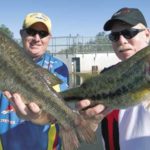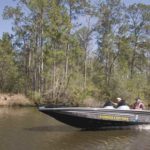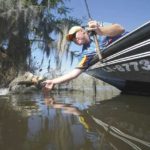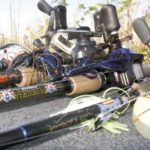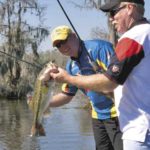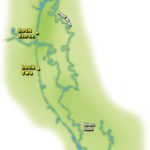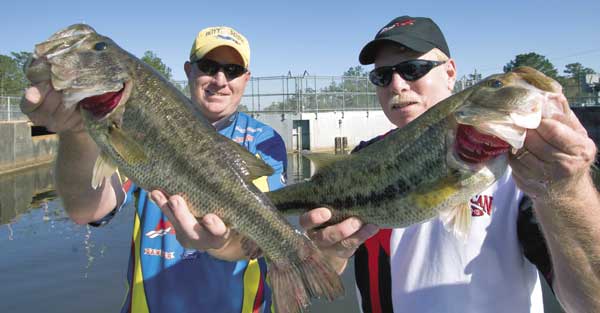
This government project didn’t exactly work out, but that’s quite alright with Pearl River-area bass anglers.
It’s hard to imagine that the Florida Parishes don’t have some type of freshwater reservoir to attract anglers. The land is similar to that in North and Central Louisiana, which have sprawling reservoirs within a short drive from anywhere in those parts of the state. There has been a little talk and a lot of resistance to constructing a reservoir in Washington Parish, but as for now, folks in this region concentrate on farm ponds, small rivers and the marshes when they want to catch some bass.
All three of these options present at least some problems. Farm ponds are private. Small rivers are swift and require small flat boats. Marshes are extremely productive, but they are also more volatile than the S&P 500 because of the influence the tide has on them.
Thankfully, there is at least one body of water in the Florida Parishes that is open to the public, can be fished out of the largest bass boats and is more stable than a certificate of deposit.
Well, at least one of the three pools in the West Pearl River Navigation Project is that stable. The other two pools have to contend with the direct influence of the Pearl and Bogue Chitto rivers.
The West Pearl River Navigation Project was authorized in 1935 as a way to provide a channel from Bogalusa to the mouth of the West Pearl River. The 20-mile canal has a series of three locks, which separate the canal into three sections.
Twenty years after its completion in 1956, the project was placed in “caretaker” status because the cost to maintain the canals could not be justified. However, local interests in Slidell and Bogalusa persuaded the U.S. Army Corps of Engineers to reevaluate the feasibility of maintaining the project, and the results indicated that maintenance of the waterway was economically justified.
Dredging began in 1989, but environmental problems got in the way, and the project was stalled again. Bureaucracy has a way of interfering with and stalling that which it is supposed to create, and boondoggles are the result.
The decline of the canal as to its original intent of being a commercial navigation system eventually led to the growth of the canal as one of the most popular fisheries in Southeast Louisiana. It may not be a sprawling reservoir, but it’s as close as Florida Parish residents are going to get for now.
According to Covington bass pro Jason Pittman, the most popular pool is the one above Lock 1 just north of the town of Hickory off Highway 41. Being that this is the only of the three pools that isn’t directly connected to a flowing river, it is the most stable of the three, and thus is considered the most productive bass fishery.
“Pool 2 has a lock at each end, but the Bogue Chitto River runs through it for a stretch,” Pittman said. “Pool 1 has a lock at each end, so they are both contained within the locks, but Pool 1 only has the Talisheek Creek running in to it, and that (creek) has some of the clearest water you’ll ever find. Pool 1 doesn’t really get any color to the water until you go above that creek.”
Pool 1 also attracts scores of anglers, along with water skiers and jet skis, because it is the longest of the pools at approximately 12 miles. This extra length allows anglers to spread out more, which results in better fishing for everybody. But Pool 1 isn’t just a straight canal. It also has several backwaters, ledges and points to make it much like fishing a reservoir.
Bush resident and Pearl River Canal veteran Chad Hartzog explained that Pool 1 is connected to a few old gravel pits like Ward’s Pit, Smith Pit and Stock Island. There is also a lake locally referred to as Becky Lake that goes beyond what any of the others offer with scores of standing cypress trees and acres of matted vegetation.
“All of these pits have points where they dump into the main canal,” Hartzog said. “And it is on those points that I typically find a bunch of bass. Other than that, there are resident fish that live out in the canal, but they can be tough to find for the untrained eye.”
Where an untrained eye sees only a bank, Pittman and Hartzog see details that lead them to the most productive stretches of Pool 1. Both anglers pay particular attention to subtle transitions that go unnoticed by many.
“It’s kind of like one of the Arkansas or Missouri lakes where fish stack up in small transitions zones, like where a chunk-rock bank changes to a pea-gravel bank,” Pittman said. “Only here, you may be fishing a clay bank that changes into a sandy bank. Or maybe you’re fishing down a bank, and it is consistently 2 feet deep, and you hit a stretch that’s 3 or 4 feet deep. That’s the kind of changes you look for out here to find fish.”
Beyond the points and the transitions zones, Pittman and Hartzog also focus on the vegetation that will grow along the edges of Pool 1. Visible grass and lily pad lines will form by the summer, and there are also stretches that accumulate duckweed and water hyacinths. Any vegetation along the canal is worth fishing.
“You’ve got a two- or three-hour window to fish that grass in the morning and again in the evening with a topwater bait,” Pittman said. “Most people hit it early with something like a Stanley Ribbit topwater frog or a buzz bait. Once the sun gets up, though, that bite typically comes to a halt.”
Another kind of productive cover along the otherwise featureless canal is the many trees that have fallen over into the water. Like the vegetation that provides cover, shade and ambush points, this fallen timber does the same.
Pittman suggested approaching the laydowns by first fishing the outer edges of the trees on the downwind side. In a straight canal like this, wind can create a current that blows through the tree limbs, and bass will position on the downcurrent side to suck up baitfish that blow through.
“I like to fish around that edge then cover all the other edges with a small spinnerbait or a shallow-diving crankbait,” Pittman said. “Then I go right down the heart of the tree with a square-billed crankbait like a 100-series Bandit or a Lucky Craft RC1 or RC1.5.
“The square bills on these lures make the baits kick around the limbs without getting hung up. With a little patience, you can work them right down the main limb to get the less-active fish that are buried up under the tree.”
One trick that Pittman uses to help him place his lures more accurately in and around the wood cover is to make roll casts with a Zell Rowland 6-foot, 2-inch American Rodsmiths spinnerbait rod. Where a longer rod would get in the way and collide with limbs and bushes, this short rod allows him to put his spinnerbait where he wants it with a simple flick of his wrist.
After working the tree over with his spinnerbait and crankbait, Pittman then picks up a jig or Texas-rigged worm to soak the tree for any remaining fish that weren’t attracted to the fast-moving lures.
While Hartzog fishes the vegetation and trees, he just loves fishing the points at the mouths of the backwater pits and creeks. He says that there may be a time to fish large lures in Pool 1, but he consistently catches more bass by downsizing to smaller lures.
“I know I catch more fish by downsizing,” he said. “Rather than throwing a 1/2-ounce spinnerbait, I throw a 1/4, and rather than pitching a 1/2-ounce jig, I throw a 1/4. It’s the same with soft plastics. I like smaller worms and small crawfish like the Zoom Speed Craw.”
According to Pittman, the large lures come more into play in the pits. These backwater lakes have deep points and ledges on which the bass position during the day, and he compares fishing these places to fishing deep points or channel ledges on a large man-made reservoir.
“Having grown up in Central Louisiana around reservoirs, I know that sometimes you need a big bait to attract the big bass that live on this kind of structure,” he said. “In Pool 1, you can catch a big fish or two by working this kind of structure with a deep-diving crankbait like a Norman DD22 or by Carolina rigging a 10-inch worm. This is the closest thing to reservoir fishing that we have in this part of the state.”
Becky Lake is an entirely different ball game. Pittman said the maze of cypress trees and vegetation scares off some anglers. Those who go in after the fish, though, are often rewarded with some good fish.
Grass and cypress-tree patterns dominate in Becky Lake, and anglers often fare well on topwater frogs like the Ribbit and Zoom Horny Toad, buzz baits, Senkos and Flukes. Punching jigs and streamlined soft plastics with heavy weights through the matted vegetation also produces for those willing to work at getting their lures below the visible mat.
Moving north to Pool 2, Pittman and Hartzog said the fishing tends to get a little tougher. While the canal remains similar, the lack of backwaters and the presence of the Bogue Chitto River opens up an entirely different situation.
“It’s been a while since I’ve fished this pool,” Hartzog admitted. “There aren’t many tournaments that go out of there from what I know, and it definitely doesn’t look as good as Pool 1 or Pool 3 in my opinion.”
Hartzog said one of the most productive techniques in Pool 2 is to fish a shad or chartreuse/blue 200 Series Bandit crankbait on the sandbars in the stretch between where the Bogue Chitto comes into the pool and where it goes over the sill.
“The one thing you do have in Pool 2 is the ability to go up the Bogue Chitto,” Pittman added. “This turns into strictly a river fishing deal with productive patterns being pitching jigs to bluff banks and into cuts and paralleling the bluff banks with a crankbait.”
Pool 3 begins at Pool’s Bluff near Bogalusa, and it is widely considered to be almost as productive as Pool 1. It doesn’t have the backwater lakes and there tends to be less cover in the water to concentrate bass.
“People that launch at Pool’s Bluff are typically going out to fish the Pearl River,” Hartzog said. “The locals know how to negotiate that big log jam just north of there, and they go over the sill, but they’re also in small flatboats.
“I stick with the canal, and most of time I catch fish on crankbaits or jerkbaits fished along the laydowns and brush that are there. I also catch a few bringing those two lures over the little drop-off that’s just off the bank.”
Anglers who decide to give the Pearl River Canal a shot this summer would do well to bring a square-billed crankbait, a buzzvbait and some kind of Texas-rigged soft plastic. According to Pittman, it might surprise some to know that the buzz bait can actually work any time of day.
“The way the canal runs, you can find shade somewhere all day long,” he explained. “I usually start the morning fishing the shade around the grass with the buzz bait to pick up active fish, then I fish any shadows I can find the rest of the day. I keep the worm ready for a follow-up lure for fish that miss the buzz bait, and I throw the crankbait in the laydowns.”
Everybody winds up fishing the same stuff in the same way during local bass tournaments, and the anglers who come out on top are those who have the patience to slow down to thoroughly cover each piece of cover. According to Hartzog, the ability to be thorough is the key to consistent catches.
Being that it’s the only game in town as far as eastern Washington and St. Tammany parishes go, the Pearl River canal system is a popular destination for anybody who loves to be on the water.
It may have not lived up to its original intent, but for the anglers of the Florida Parishes who have too far to drive to get to a reservoir, this boondoggle has become a bass fishing bonanza.
